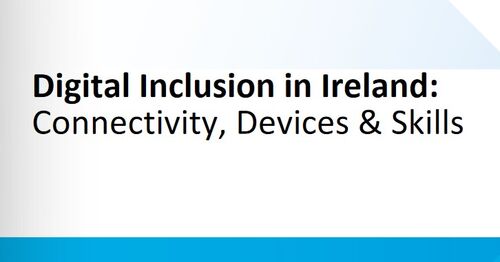On Thursday June 1st, the National Economic & Social Council launched the Digital Inclusion in Ireland: Connectivity, Devices & Skills report. The report explores the levels of digital adoption across the country and covers the various barriers to digital inclusion, namely connectivity, skills and confidence, and material access.
Connectivity
According to the report the proportion of Irish households with broadband access in 2019 was 90 percent (92% by most recent 2020 estimate), compared to an EU average of 88 percent (89% in 2020). These figures do not hold true across the country with mostly urban areas faring better than rural areas. In 2019, in the Border region 20 percent of households, and 10 percent of households in the West, reported a lack of broadband availability. 25 percent of those surveyed in rural areas had daily problems with quality of mobile-phone coverage.
CSO data for 2019 also shows differences along class lines. Only 60 percent of working-class households reported as having a fixed broadband connection, compared to 72 percent in middle-class households. In addition, the data indicates that many lower income households had either no broadband or mobile broadband only. The report indicates that Ireland’s broadband costs being one of the highest in the EU is likely a contributing factor in the lower connectivity rates of lower income households.
Older age groups show lower levels of internet connectivity. In 2018, 86 percent of the 50-69 year-old age group had home internet while only 38 percent of the 80+ year-old age group did. This is most likely due to a skill deficit in older age groups and different relationship to the internet. A cohort of roughly 3 percent in this age bracket was solely reliant on internet access external to their homes, including friends/relatives homes, library/community centres, and public Wi-Fi networks.
Skills and Confidence
In terms of basic digital skills, Ireland lags behind at 53 percent of adults compared to the EU average of 58 percent. This was affected by a number of factors affected the low levels of digital skills. Older Irish people have lower uptake of new technologies, with 33 percent having never used the internet in 2019, compared to 11 percent in Britain. Rural areas tend to have lower online engagement, often due to lack of infrastructure in the area. Then there is the clear socio-economic divide, where the unemployed, those with lower education, lone-parent households, and lower income households all being less likely to own a digital devices. Out of those currently in employment 58 percent have used word-processing recently while only 41 percent of the unemployed have, and 85 percent of the most affluent quintile used internet banking recently compared to 62 percent of the least affluent.
These trends are backed up by Eurobarometer data, which shows that Irish people who do not feel sufficiently digitally skilled are more likely to be older, less well off, less educated, and living in rural areas. A fifth of whom said that a lack of training opportunities, spare time, and knowing what skills to acquire, along with cost were barriers to improving digital skills.
Another issue raised by the report is that, in addition to the mechanical operation of digital devices and applications, content literacy is of increasing importance. Content literacy representing the ability to engage critically with intellectual and cultural activities people engage in online.
Material Access
The report could find no data on the socio-economic breakdown of computer ownership. Although there was a corelation between laptop ownership and having home broadband, with 84% of laptop owners having home broadband. Considering what we know about households with home broadband, this raises the likelihood that there is a link between household wealth and laptop ownership.
There is however data on phone ownership, with 79 percent of working-class people owning a smartphone compared to 91 percent for middle-class people. There is also a higher percentage of working-class people whose phone is over three years old, with 41 percent for working-class people compared to 29 percent for middle-class people.
There was also data which indicated that in general, the older a person is, the less likely their engagement with ICT. 60 percent of the 70–79 year-old age group have access to a smartphone/tablet, whereas only 30 percent of those over 80 do.
Currently, Ireland stands in 7th place in Digital Economy and Society Index (DESI) human capital index, but stands to improve in the proportion of the population with at least basic digital skills. Building digital capital in society can pay dividends in the long run. The report notes that “UK research shows a strong multiplier from investing in digital skills and devices to combat digital exclusion; £15 benefit for every £1 invested (CEBR, 2018).” (p5)
To read the full report please follow this link.
